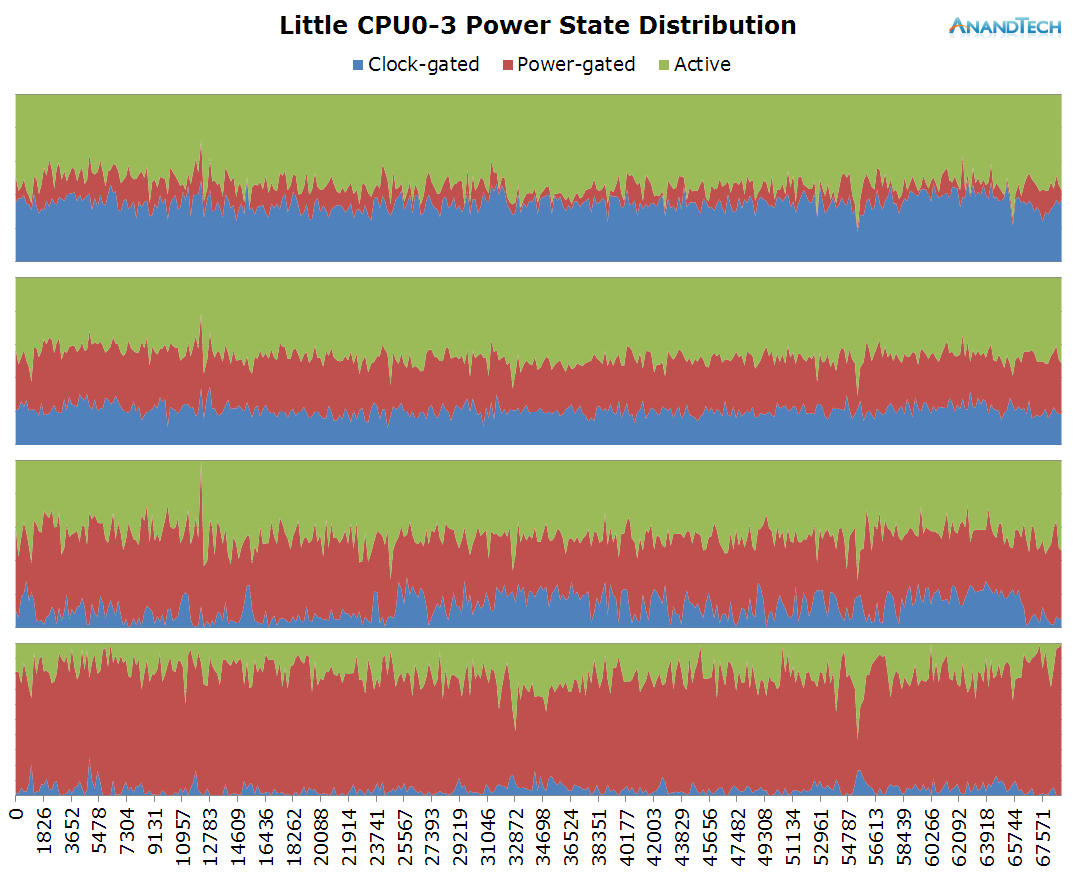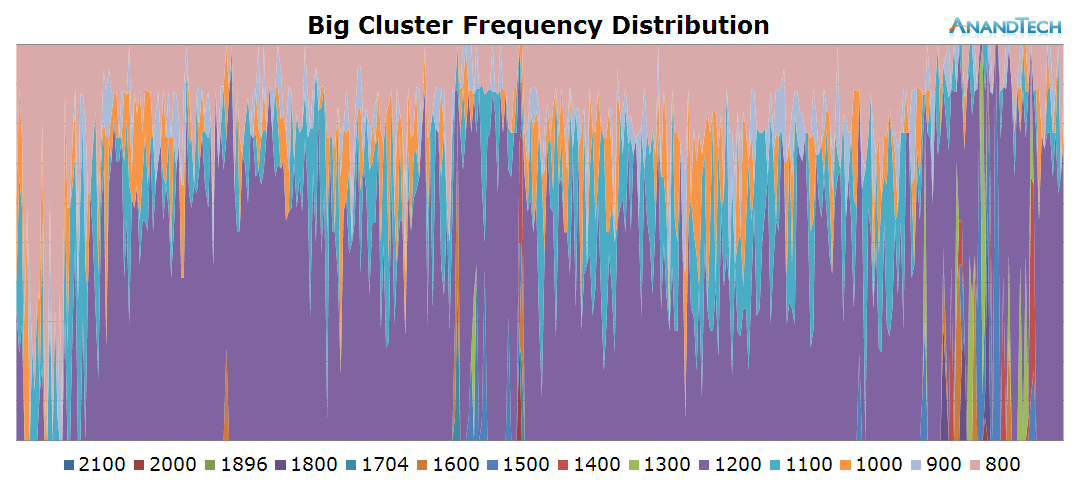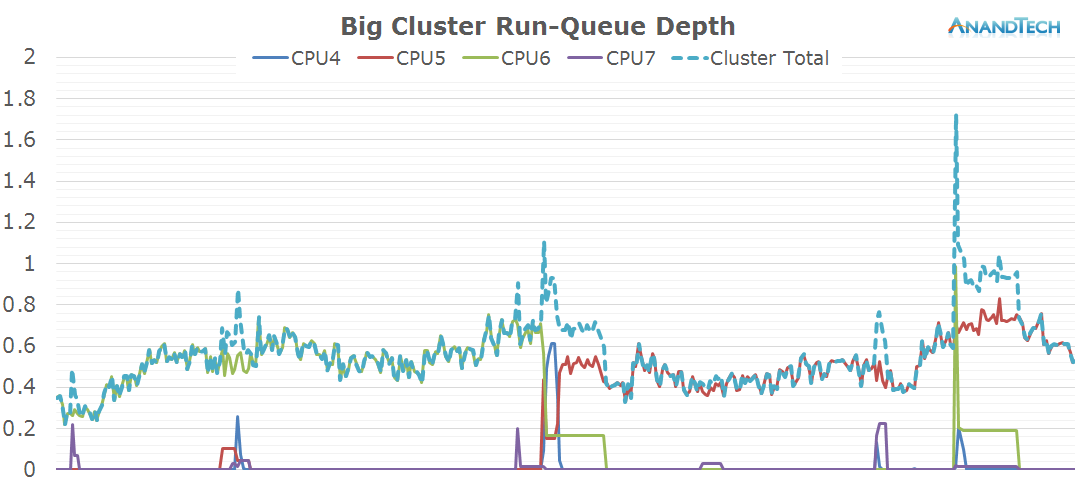The Mobile CPU Core-Count Debate: Analyzing The Real World
by Andrei Frumusanu on September 1, 2015 8:00 AM EST- Posted in
- Smartphones
- CPUs
- Mobile
- SoCs
Modern Combat 5 Playing
The little cluster looks to behave extremely similar to what we saw in Real Racing 3: Three larger threads keep 3 of the cluster's CPU at relatively busy duty-cycles while we see some limited activity on the 4th core.
The big cluster also seems to behave in a similar fashion. One big main thread causes the bulk of the load while we only have occasional small bursts when threads get migrated onto the big cluster. This time we see a more variable load both in terms of requency and rq-depth instead of the flat-line that could be observed in Real Racing 3.
One interesting behaviour caught in this log was how the main big thread got moved around from CPU6 to CPU4 and then again to CPU5 on the 33s mark in the log.
Even though the total rq-depth might be a bit misleading here while it's showing an average of around 2.5, we can see that in the individual per-CPU runqueues we have 4 major threads at work. Again this is a case of using parallelization for the sake of power efficiency instead of performance. The 3 smaller threads on the little cores could have well been handled by a single larger CPU at higher frequency, but it wouldn't have been nearly as power efficient as spreading them onto the smaller cores.

















157 Comments
View All Comments
V900 - Tuesday, September 1, 2015 - link
A question that DOESNT get answered however is: Does the fact that all cores get used, contribute to a better/faster user experience?If there was only 2 or 4 cores present, would they complete the tasks just as fast?
In other words, Is there a gain from all 8 cores being used, or does all 8 cores get used just because they are there? (By low priority threads, which in a quad/dual core CPU would have been done sequentially, in just as fast a time?)
Since Apples dual core iPhones, always outperform Android quad and octa core phones, I would think that the latter is closer to the truth.
Read up on what some of the other posters here have written about low priority threads, and Microsofts research on the matter.
And ignore anyone who tries to over-interpret this article!
frenchy_2001 - Wednesday, September 2, 2015 - link
> Does the fact that all cores get used, contribute to a better/faster user experience?It does not, as long as you CPU can process all the threads in a timely manner.
It contributes to a lower power usage though, as power grows following the square of Voltage and voltage usage grows with frequency, while parallelization grows linearly.
Basically, if 2 A53 @ 800MHz can do the same amount of work as 1 A53 @ 1.6GHz, the 2 slower cores will do it for less power (refer to the perf/W curve on the conclusion page).
This was the goal of ARM when they designed big.LITTLE and this article shows that the S6 uses it correctly (by using small cores predominantly and keeping frequencies low). It is one more trick to deliver strong immediate computation, good perfs/W at moderate usage and great idle power while idling. I would not extrapolate beyond that as too many variables are in play (kernel/governor/HW/apps...)
name99 - Tuesday, September 1, 2015 - link
"When I started out this piece the goals I set out to reach was to either confirm or debunk on how useful homogeneous 8-core designs would be in the real world"You mean heterogeneous above rather than homogeneous.
Andrei Frumusanu - Tuesday, September 1, 2015 - link
No, I meant specifically 8x A53 SoCs.lilmoe - Tuesday, September 1, 2015 - link
I've been waiting for this piece since the GS6 came out. I can't even imagine the amount of time and work you've put into it. THANK YOU Andre.Now I hope we can put to rest the argument that Android would do better with only 2 high performance cores VS more core configurations. Google has been promising this for years and they're finally _starting_ to deliver. They're not there yet, lots of work needs to be done to exterminate all that ridiculous overhead (evident in the charts).
I'm also glad that it's finally evident that Chrome on Android VS SBrowser has significant impact on performance and battery life. It should only be fair to ask that Anandtech starts using the built-in browser for each respective device when benchmarking.
We're _just_ reaping the benefits of properly implemented big.LITTLE configurations, in both hardware and software, after 2 years of waiting. What's funny is that both Qualcomm and Samsung are moving away from these implementations back to Quad-core CPUs with Kryo and Mongoose respectively... I personally hope we get the best of both worlds in the form of Mediatek's 10 core big.LITTLE implementation, except the 2 high perf cores being either Kryo or Mongoose for their relatively insane single-threaded performance.
V900 - Tuesday, September 1, 2015 - link
You're coming up with conclusions that aren't aupported by the article.Can we put 2 vs 8 core argument to rest? Nope.
This test only shows, that when there are 4 (or 8) cores available, Android occasionally uses them all.
It says NOTHING about whether an 8 core CPU would be faster than with 2 wide cores. (Samsung and Qualcomm are moving towards Apple-like wide dual core designs. I doubt they'd do that, if 8 cores were really always faster/economical than 2)
In fact, the article doesn't really tell us whether 8 small cores are faster/more economical than 2 or 4 small cores. Keep in mind what people have brought up about the priority of threads. Some of the threads you see occupying all 8 cores, are low priority threads, that could just as quickly be completed in sequence if there were only 2 or 4 low power cores available.
lilmoe - Tuesday, September 1, 2015 - link
"Can we put 2 vs 8 core argument to rest? Nope."Are you sure we're on the same page here? We're talking efficiency, right?
"This test only shows, that when there are 4 (or 8) cores available, Android occasionally uses them all."
No it doesn't. Android is capable of utilizing all cores, yes, but it only allocates threads to the amount of cores *needed*, which is much, MUCH more power efficient than elevating a smaller number of high performance cores to their max performance/freq states.
"It says NOTHING about whether an 8 core CPU would be faster than with 2 wide cores. (Samsung and Qualcomm are moving towards Apple-like wide dual core designs. I doubt they'd do that, if 8 cores were really always faster/economical than 2)".
True, it doesn't show direct comparisons with modern wide cores running Android, because there isn't any. But even taking MT overhead and core switching overhead into account, I believe it's safe to say that things should be comparable (since the small cluster is rarely saturated), except (again) much more efficient. And no, QC and Samsung aren't moving to any dual core configuration; they're both moving to Quad-core configuration (ie: the most optimal for Android), which further proves the argument that more cores running at a lower frequency (and lower power draw) is more efficient than having fewer cores running at their relative max for MOBILE DEVICES.
The problem isn't the premise, it's the means. ARM's reference core designs aren't optimal in comparison to custom designs neither in performance nor in power consumption. Theoretically speaking, if Qualcomm or Samsung use little versions of their custom cores in 8-core configurations, or 4x4 big.LITTLE, we might theoretically see tremendous power savings in comparison. Again, this applies to Android based on this article.
"In fact, the article doesn't really tell us whether 8 small cores are faster/more economical than 2 or 4 small cores."
This article STRICTLY talks about the impact of 4x4 core big.LITTLE configuration has on ANDROID if you want BOTH performance and maximum efficiency. It clearly displays how Android (and its apps) is capable of dividing the load into multiple threads; therefore having more cores has its benefits. Also, you can clearly see that there is noticeable overhead here and there, and throwing more cores at the problem, running at lower frequency, is a better brute force solution to, AGAIN, maximize efficiency while maintaining high performance WHEN NEEDED, which is usually in relatively short bursts. Android still has ways with optimization, but its current incarnation proves that more cores are more efficient.
You are making the wrong comparisons here. What you should be asking for is comparisons between a quad-core A57 chip, VS an 8-core A53 chip, VS a 4x4 A57/A53 big.LITTLE chip. That, and only that would be a valid apples-to-apples comparison, which in this case is only valid when tested with Android. Unfortunately, good luck finding these chips from the same manufacturer built ont he same process...
lilmoe - Tuesday, September 1, 2015 - link
"they're both moving to Quad-core configuration (ie: the most optimal for Android)"In regard to large/wide core non-big.LITTLE designs that is.
lefty2 - Tuesday, September 1, 2015 - link
You are right. The article is deeply flawed. Nowhere is there any evidence of a 4 core device rendering a web page faster than a 2 core.lopri - Wednesday, September 2, 2015 - link
Qualcom's next custom core is 2+2 but Samsung's is 4+4. But I agree with the gist of your argument. Different core counts, but they all aim the same goal - performance and efficiency.